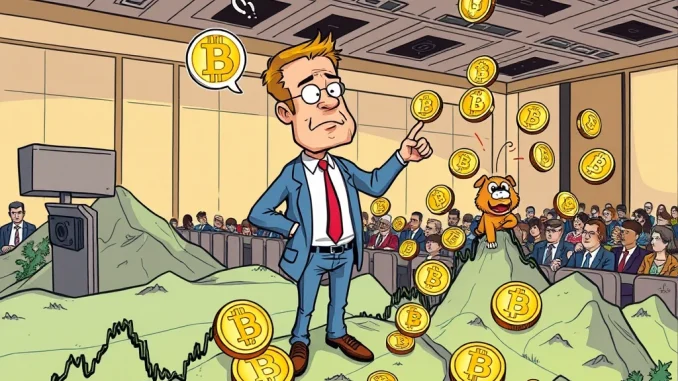
At Consensus 2025, a major cryptocurrency conference, Barstool Sports founder Dave Portnoy didn’t hold back. Speaking candidly, he described meme coins not as serious investments, but simply as a form of crypto gambling. His blunt assessment, delivered during a conversation with Bullish CEO Tom Farley, highlighted the extreme volatility and short-term nature he sees in this corner of the market.
Dave Portnoy’s History with Meme Coins
Dave Portnoy is no stranger to the world of meme coins. He has publicly documented his forays into this space, often with dramatic results. His experiences have been a rollercoaster, marked by both brief windfalls and significant losses.
He specifically mentioned tokens like SafeMoon, a popular meme coin that saw massive price swings before facing controversy and decline. These personal encounters appear to have shaped his strong opinions, leading him to view meme coins through the lens of high-stakes speculation rather than traditional investment.
Why Dave Portnoy Calls It Crypto Gambling
Portnoy’s classification of meme coins as crypto gambling stems from several observations and personal experiences. Unlike established cryptocurrencies with clear use cases or underlying technology, meme coins often derive their value purely from hype, social media trends, and community speculation.
Key reasons behind his view include:
- Extreme Volatility: Prices can skyrocket or plummet within hours, driven by social media sentiment rather than fundamentals.
- Lack of Intrinsic Value: Many meme coins are created with little to no utility or technological innovation.
- Pump-and-Dump Potential: The market structure is susceptible to manipulation, where early buyers or large holders can significantly influence the price before selling off.
- Insider Influence: Portnoy echoed reports suggesting the space is often dominated by a few insiders using bots and sophisticated trading strategies, making it difficult for average participants.
Lessons from SafeMoon and Other Ventures
Portnoy’s journey with SafeMoon is a prominent example he often references. He invested, saw substantial gains on paper, only to experience significant losses later. He even faced legal challenges related to some of his crypto promotions, adding another layer of complexity and risk to his involvement.
These volatile experiences, including his brief involvement with tokens like SafeMoon and others (he mentioned Libra, though this likely refers to a different project than Meta’s stablecoin attempt), reinforced his perception that success in meme coins relies more on luck and timing than on sound investment principles. It felt less like investing in a project and more like placing a bet.
Consensus 2025: A Platform for Frank Discussion
The setting for these remarks was Consensus 2025, one of the cryptocurrency industry’s most significant annual gatherings. It’s a venue where industry leaders, investors, and commentators discuss the latest trends and challenges.
Portnoy’s presence and candid comments at such a high-profile event underscore that the speculative nature of meme coins is a topic of serious discussion, even among those involved in the broader crypto space. His perspective, coming from someone known for his direct style and past involvement, offered a dose of skepticism amidst the usual industry optimism.
Are Meme Coins “Built to Last”?
Portnoy expressed significant doubt about the long-term sustainability of meme coin culture. While acknowledging their excitement and appeal – the potential for quick, massive gains is undeniable – he ultimately sees them as fleeting phenomena.
He controversially called the culture “a Ponzi scheme, not in a negative way, but not built to last.” This isn’t a legal accusation of fraud but rather a description of a structure that relies on a constant influx of new participants and capital to sustain itself, lacking a durable foundation once the hype fades. This perspective aligns with his view that meme coins are primarily crypto gambling.
Key Takeaways for Anyone Considering Meme Coins
Based on Dave Portnoy’s experience and comments at Consensus 2025, what should potential participants consider?
- High Risk: Understand that meme coins are extremely speculative. You could lose your entire investment.
- Do Your Own Research (DYOR): While fundamentals are often minimal, try to understand the project’s community, token distribution, and any potential utility. Be wary of projects with anonymous teams.
- Beware of Hype: Don’t get swept up in social media frenzy. Price pumps can reverse just as quickly.
- Assume it’s Gambling: As Portnoy suggests, approach it with the mindset that you are placing a high-risk bet, not making a traditional investment. Only use funds you can afford to lose.
- Learn from Examples: Research the history of past meme coins, including the trajectory of tokens like SafeMoon, to understand the potential pitfalls.
Summary: Portnoy’s Cautionary Tale
Dave Portnoy’s remarks at Consensus 2025 serve as a cautionary tale about the volatile world of meme coins. Drawing from his own turbulent experiences with tokens like SafeMoon, he painted a picture of a market driven by hype, speculation, and insider activity, classifying it firmly as crypto gambling.
His doubts about the long-term viability of meme coins and the culture surrounding them highlight the significant risks involved. While the allure of massive returns is powerful, Portnoy’s perspective, shared at a major event like Consensus 2025, is a stark reminder that these assets are “not built to last” and should be approached with extreme caution.



